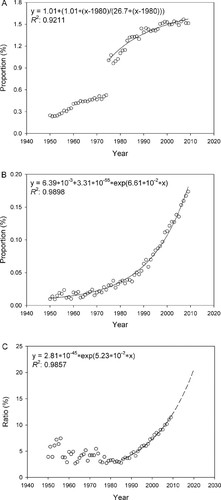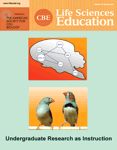Implications for Undergraduate Education of Two Interdisciplinary Biological Sciences: Biochemistry and Biophysics
Dear Editor:
As CBE—Life Sciences Education readers know, modern biology has become more quantitative and mechanistic rather than qualitative and phenomenological. Indeed, the American Society for Cell Biology (2010) notes that “biology learning encompasses diverse fields, including math, chemistry, physics, engineering, and computer science, as well as the interdisciplinary intersections of biology with these fields.” Because of this, interdisciplinary biology courses are increasingly critical for preparing undergraduates for further education and careers in the life sciences. The problem is that many institutions do not reflect this in their undergraduate course offerings. In this letter, we show that the growth of two biological disciplines, namely biochemistry and biophysics, can be described in terms of their representation in the research literature. On this basis, we make predictions about the future trends of research in these disciplines and the implications of these trends for undergraduate education.
The most widely taught interdisciplinary biological science is probably biochemistry. Many undergraduate biology and chemistry departments recognize its importance and offer it as a core course in their curricula. Biophysics is another interdisciplinary biological science. Although it is not as popular as biochemistry, the growing importance of the subject should be recognized by teaching institutions and reflected in their course offerings. Unfortunately, it seems that the number of institutions that have noticed the demand for it is limited. For example, out of 34 undergraduate institutions in the University of Georgia System (2010), only 5 offer an undergraduate biophysics course or related courses, such as physical biochemistry. In contrast, 8 of the top 10 universities listed in U.S. News and World Report (2010) teach biophysics or physical biochemistry.
Here, we offer a brief analysis of the primary life sciences literature to support our argument for widespread teaching of biophysics at the undergraduate level. Specifically, we used the number of papers indexed by PubMed (National Center for Biotechnology Information, 2010) as a measure of subject importance. We searched PubMed with search terms “biochemistry OR biochemical” for biochemistry and “biophysics OR biophysical” for biophysics with a limit of the search to title/abstract for each year from 1950 to 2009. We then normalized the number of papers for each subject to the total number of papers in each year. We recognize that there are limitations to this approach. For example, the DNA structure paper by Watson and Crick (1953) is not counted as either a biophysics or a biochemistry paper because it does not contain the search terms in its title or abstract. Yet we believe that this metric reasonably represents the activity of the subjects relative to one another.
Figure 1 shows the normalized number of papers of biochemistry and biophysics, from which we draw three conclusions. First, biochemistry has been continuously growing, with a large increase between 1974 and 1975. This growth may explain why biochemistry is now widely taught. Second, the normalized number of biochemistry publications approaches an asymptotic value suggesting saturation (Figure 1A), although we cannot rule out the potential for major transitions in biochemistry research to prompt new growth in the field in the future. Third, although the discipline of biophysics is younger than that of biochemistry, it has been growing exponentially (Figure 1B). This feature can be more clearly seen in Figure 1C, where the number of biophysics papers was normalized to that of the biochemistry papers. Figure 1C indicates that the relative importance of biophysics was ∼12% in year 2009, but if the trend of the last 25 years is maintained for the next 10 years, it will be ∼20% in year 2020. Current biology seems to be facing the same “cultural transition” that chemistry faced ∼100 years ago when it started including physics-based approaches in education and research. This incorporation of physics in chemistry resulted in physical chemistry, one of the core areas in chemistry today (Servos, 1996). Figure 1. Proportion of biochemistry (A) and biophysics (B) papers in PubMed and their ratio ( = biophysics/biochemistry) (C). Extrapolation of the fitting equation is shown as a dashed line (C). Nonlinear curve fitting was performed using SigmaPlot (version 11; Systat Software, San Jose, CA). Fitting equations and their R2 values are included in the figures.
This analysis reveals the major upswing in biochemistry publications that occurred between 1974 and 1975. We offer a hypothesis to explain this phenomenon: the introduction of a great textbook. We propose that Biochemistry by Lehninger (1970), which has been widely recognized since its initial publication (Sable, 1971), is the original modern biochemistry textbook. Perhaps groundbreaking instructional resources such as this can trigger a quantum leap in research in the discipline. Unlike biochemistry, biophysics suffers from the lack of consensus on the standard topics and skills that should comprise an undergraduate course. This is an issue that biologists and biophysicists need to solve together.
In conclusion, if training future biologists is one of the goals of undergraduate biology education, then our analysis indicates that we need to make biophysics a standard component of the curriculum, similar to biochemistry.
ACKNOWLEDGMENTS
This work was partly supported by Valdosta State University (Reassigned Time fund to J. Kang). The content in this letter is not necessarily the view of Valdosta State University.



